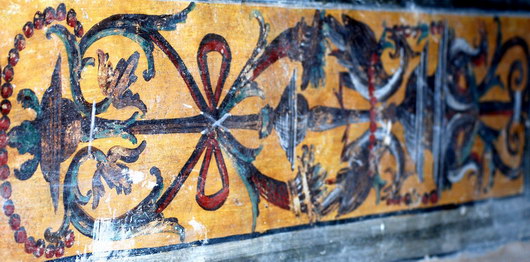|
The Oratory, with its thousand years of history, stands within the village's oldest settlement. Set in close proximity to the Church of Santa Croce, it comprises, at present, an open entrance and a rectangular hall, 26 meters long and 7 wide, covered by a wooden truss roof. The Oratory, of relevant value in itself, is further enriched by the frescoed walls within, which present stratifications of arriccio –a fresco's rough underlayer– from different time-periods.
The Virgin with Child with Saint John the Baptist and Saint Nicholas, dating from the middle of the fourteenth century, is a powerful testimony to the building’s importance, and to the pre-eminent role which the Company of the Disciplinati from Moneglia held in its epoch’s society. The table, painted for the Oratory itself, is today part of the Chiavari Diocese’s Museum’s collection. Recent analyses have revealed the Oratory’s very complex architectonic and decorative history, with frescoes superimposed to one another in different time-periods (in the thriteenth, fourteenth, sixteenth and eighteenth Centuries). The Oratory itself underwent an initial transformation before the sixteenth century: its structure was enlarged, and the new perimeter encompassed three arched doorways, traces of which can be perceived to this day on the counter-façade. Originally, these arches might have belonged to a portico or to another room set next to the building's ancient nucleus. Accordingly, the six slender single-light windows whose traces were found on the right wall present characters which are quite typical of late-medieval building styles. In the seventeenth century, the Oratory's floor was lifted and the orientation changed. Also, the great wooden altar was built, leaning on the far wall, as well as a balcony for the seventeenth-century organ, decorated with canvases of musical angels. An extraordinary complexity characterizes the frescoed paintings which cover, in overlapping layers, all of the Oratory’s walls. The same complexity can be noted in the artwork's narrative development, which presents a plethora of styles and influences stemming from a veritable melting pot of cultures. Tuscan and Lombard accents prevail, lending the Oratory’s pictorial cycle rich, evocative touches. 
|
 The Oratory of the Disciplinanti
The Oratory of the Disciplinanti 